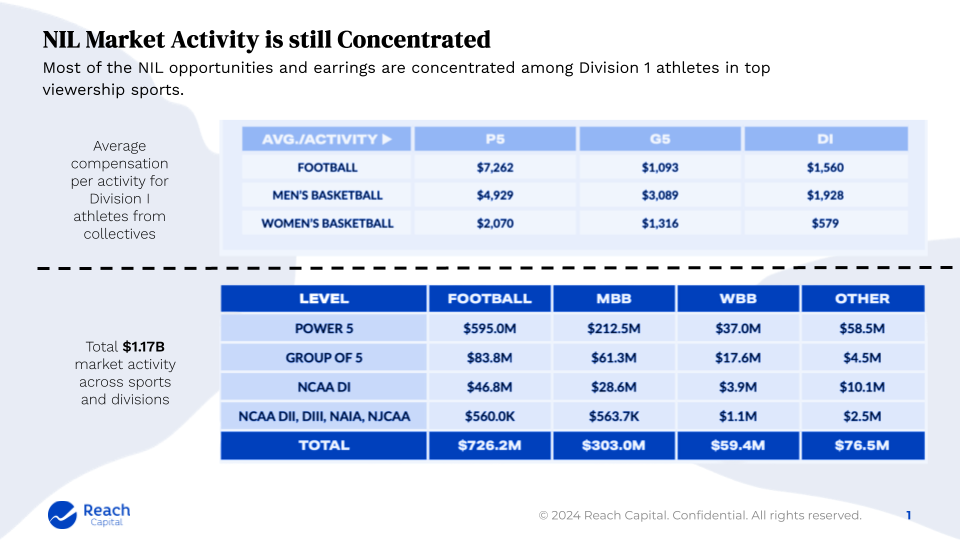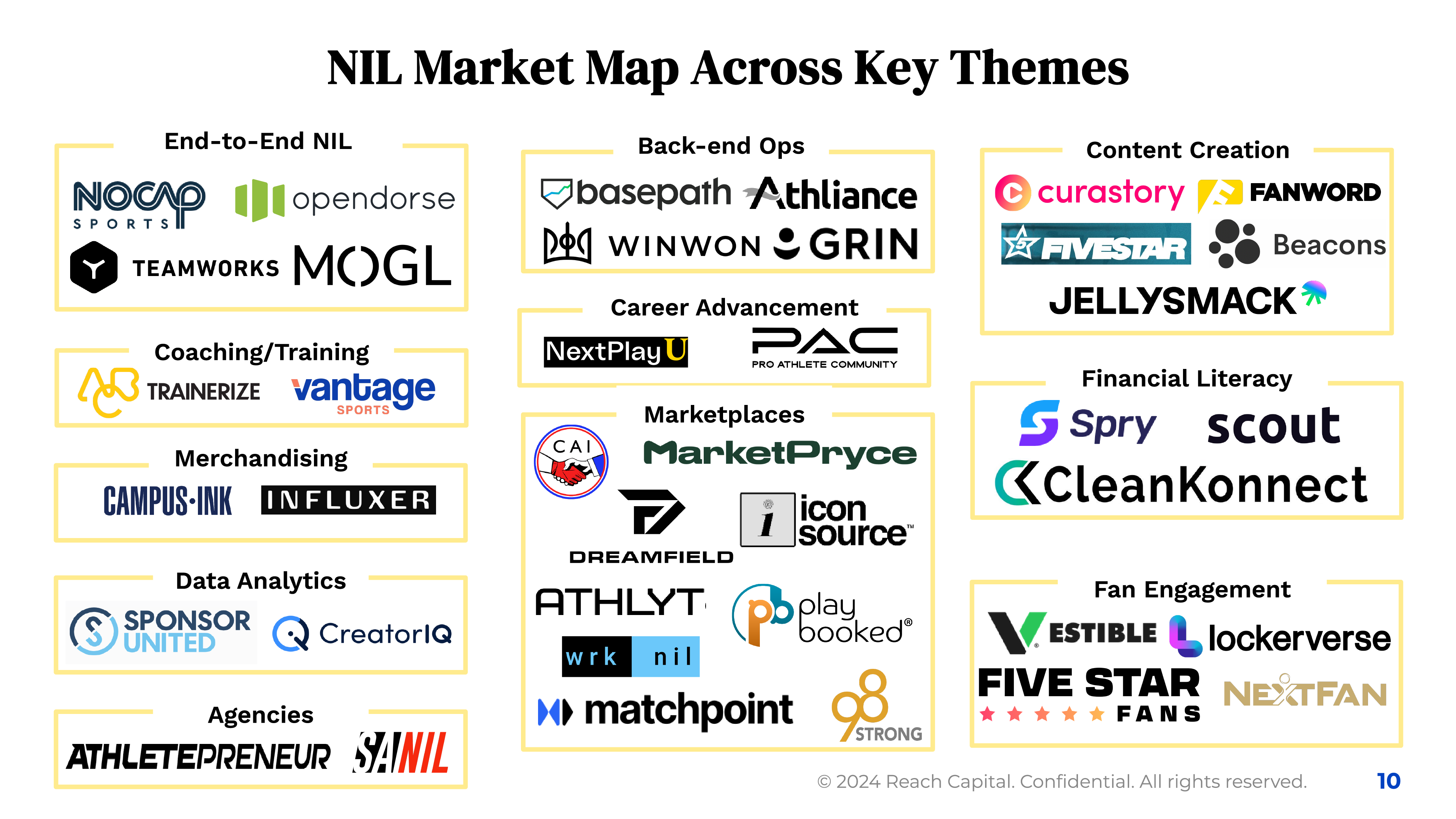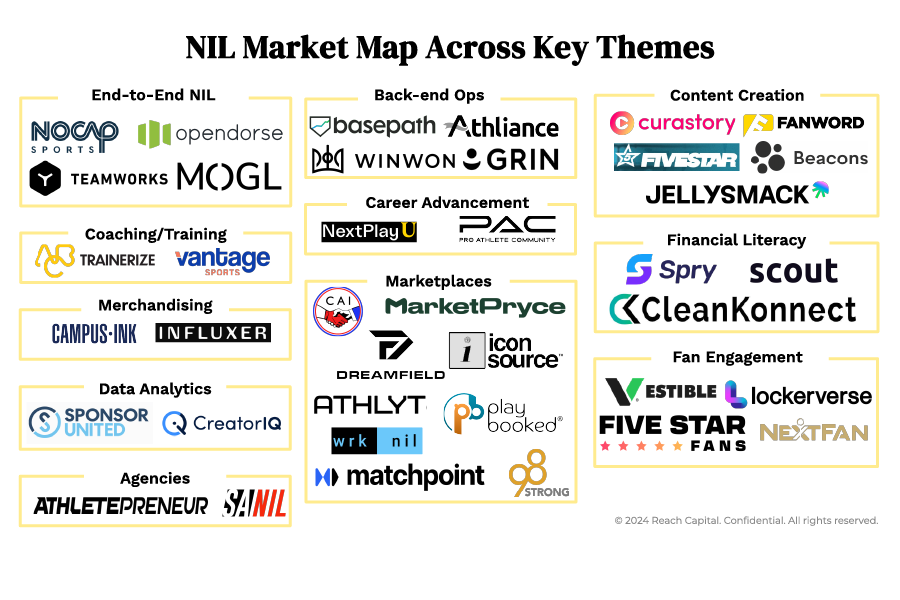With football season underway, the future of college sports is being rewritten before our eyes.
At Reach Capital, we’re not just investing in startups, we’re investing in the future of learning. Welcome to “Beyond the Game,” a two-part journey into the heart of youth and collegiate athletics. This isn’t just about touchdowns and championships; it’s about the transformation of young athletes into empowered learners.
In Part I, we’re diving headfirst into the NIL (Name, Image, and Likeness) revolution that’s turning college sports on its head now that college athletes can profit from their personal brand through sponsorships, endorsements, and other commercial activities. Prior to 2021, the NCAA prohibited college athletes from profiting off their name, image, and likeness. This summer, we took time to get up to speed on this ever-changing and complex NIL landscape. Led by our very own Demetrius Palmer, a Reach Capital-BVCC Investor Fellow, we recruited two incredible student-athletes, fresh from their 2024 College Football National Championship victory with the University of Michigan: Jayden Denegal (QB, #4) and Stone Anderson (Punter, #92). These young players were our eyes and ears on the ground, bringing us unfiltered insights straight from their own team and student-athletes across the country.
Why is the NIL market important to understand? Not only are we seeing a changing landscape in the regulatory environment of college sports, but a great economic shift toward the student-athlete. Opendorse (an NIL marketplace and tech platform) recently published an annual report on the state of the industry. In 2023-2024, NIL deals reached over $1.2B. For 2024-25, it is projected to reach $1.67 billion and potentially exceed $2.5 billion by 2025-2026 if revenue sharing is implemented. According to Morgan Stanley’s Global Sports & Entertainment Playbook on NIL, in 2023, brand compensation to student-athletes grew 300% YoY. As one may expect, football receives the largest share, with 72.2% of collective NIL spending, followed by men’s basketball at 21.2%. Women’s sports receive much smaller portions (but will hopefully shift soon), with women’s basketball only garnering 2.3% of collective spending.

As impact investors, as we peel back the curtain on NIL and explore its promises and challenges, there are several top-of-mind questions:
- How is NIL reshaping the college experience?
- Are we empowering student-athletes or exploiting them?
- What does this mean for the future of amateur sports?
From Oars to Empires: A Brief History of the NCAA
Intercollegiate sports in the U.S. began in 1852, starting with rowing at Harvard and Yale. In 1906, the establishment of the National Collegiate Athletic Association (NCAA) came to be the main governing entity for all college sports. Over the NCAA’s complex history, notable initiatives included:
- Post-WWII: The adoption of “Sanity Code” principles that covered financial aid, recruitment, and academic standards, intended to ensure amateurism in college sports.
- 1972: The landmark Title IX was established, prohibiting sex-based discrimination in educational programs and activities that receive federal funding, including sports programs.
- 1973: The NCAA split into three divisions, each a separate entity with its own rules and legislation, to create a more even playing field and promote fairness in competition.
- 2021: The Supreme Court found that NCAA restrictions on “education-related benefits” violated antitrust law. Historically, the NCAA’s strict amateurism rules prohibited student-athletes from receiving compensation beyond scholarships. Since then, collegiate sports have been fundamentally transformed by the NCAA’s decision to lift restrictions over “Name, Image, and Likeness (NIL) rights” in college sports, allowing athletes to profit from their personal brand.
Now that the “professionalism” of college athletes has officially arrived, the U.S. collegiate sports landscape will never be the same.
The Student-Athlete Perspective
Armed with the tenacity that won them a National Championship, Jayden and Stone surveyed a diverse pool of 40 student-athletes, representing over 15 collegiate sports across 12 colleges in Division I, II and III. Beyond just surveying and collecting data, this analysis allowed students to voice their own hopes and concerns around NIL.
Most students reflected overall optimism in the future of NIL and are in support of more equitable compensation to student-athletes, recognizing how much student-athletes contribute to the ever-growing, multi-billion-dollar industry of college sports, driven by media rights. NIL provides them with deserved economic opportunities and the ability to leverage their personal brands for internships, endorsements, and other entrepreneurial opportunities.
Following these lines, students also expressed interest in being able to access not just more NIL opportunities, but also support and education in management, contract negotiations, and financial literacy. They also want greater transparency from universities to better understand the regulations.
At the same time, there are legitimate concerns that NIL could undermine the educational priorities of student-athletes, exacerbate recruitment disparities, and threaten the integrity of amateur sports by creating an uneven playing field.
A few key stats we uncovered from our survey:
- 94% believe athletes will transfer to pursue more NIL opportunities
- 81% believe NIL will influence athletes to remain in college longer
- 63% believe NIL will create inequality based on sport, gender, and other factors
- 31.3% worried about team dynamics and culture
You can find more details on the results of our student survey, detailing the perceived benefits and concerns of the impact of NIL below:
Beyond student-athletes, our investigation expanded into the heart of the sports world, interviewing former NFL players, college athletic directors, sports agents, lawyers and startup founders. Among the many overlapping themes we uncovered, there were several important questions:
- Do colleges want to optimize for the sports mercenary or athletic scholar?
- How do student-athletes balance the demands of their athletic program with their academics?
- How do we actively prevent the exploitation of athletes, particularly those from disadvantaged backgrounds?
- How do we educate all stakeholders on long-term health care and support for athletes over time?
- What is the new role of the NCAA or any new governing entity that arises? How do we navigate the current lack of regulatory oversight in an unconstrained market?
Technology is Transforming NIL Earnings for Athletes
Alongside the changing regulatory environment, we are also entering a new phase of technological innovation that will spawn a new market of stakeholders and businesses creating new tools, software and services around NIL in sports. We believe this shift will not only benefit student-athletes but also introduce significant investment opportunities through the growth of digital platforms that facilitate NIL transactions, tools that provide financial literacy and independence, platforms that craft athlete-brand collaborations, and productivity software for athletic departments managing more complex operations and administration around NIL.
Aligned with Reach Capital’s broader thesis around learner empowerment, we see the evolution of NIL rights not just as a market opportunity but as a chance to empower student-athletes with support focused on financial independence, educational advancement, and career development. We look for investments such as (but not limited to):
- Platforms that provide greater financial independence and protection to the student-athletes and their families from predatory or exploitative practices (from deal negotiations and contract reviews to regulatory policy and financial literacy) Solutions that provide alternative career pathways for the 98% of college athletes who won’t play professionally
- Software for universities and collectives to allow for greater efficiency and optimization of revenue generation and distribution
- Services and tools that promote economic inclusion and mobility for underrepresented and financially disadvantaged scholars
The NIL ecosystem is well-suited for the integration of tech-driven solutions across multiple sectors:
- Financial Services & Tools: Platforms that offer budgeting, tax planning, and investment advice tailored to the unique needs of NIL income earners.
- Educational Resources: Online courses and tools to boost financial literacy, personal branding, and contract negotiation skills.
- Marketplace Platforms: Digital hubs that connect athletes with endorsement opportunities, streamlining the deal-making process.
- Content Creation & Social Media: Tools that assist athletes in monetizing their personal brands and engaging directly with fans.
- Compliance & Legal Services: Services that ensure adherence to the complex web of NIL regulations and protect athletes from predatory contracts.
We identified a few key categories to help frame the current (and quite nascent) NIL startup landscape. (See Market Map below)

One of the earliest entrants in the NIL space is Opendorse, a marketplace that raised over $50 million to help student-athletes navigate the NIL landscape, providing: 1) a marketplace that connects athletes with NIL opportunities; 2) an education platform to understand NIL policies and how to build a personal brand ; 3) a content management and publishing platform for an athlete’s social media; 4) a compliance monitoring to track an athlete’s NIL activity. It was founded by two former Nebraska football teammates, Blake Lawrence and Adi Kunalic. Another example in the fintech space is Scout, founded by Michael Haddix Jr., an astute former collegiate athlete turned entrepreneur. A Reach portfolio company, Scout is the first digital family office solution for college athletes that combines financial education, wealth management, and tax preparation with a premium financial concierge service that gives their players the same level of support as the best pro players. University customers include Iowa, Texas A&M, Florida, Siena, and Depaul.
We anticipate a growing number of new entrants to rapidly build across these categories in the coming months, and we are excited to focus on the most impactful and durable solutions that empower the student-athlete over the long term.
Where We Go From Here
The game has changed and there’s no going back. The only question is, are we ready for what comes next? As NIL deals become the new recruitment currency, the very fabric of college sports hangs in the balance: In this brave new world of collegiate athletics, will talent and hard work still triumph, or will money become the ultimate game-winner?
The perspectives of student-athletes paint a picture of a system in flux, where the rules of engagement are being written in real-time. At Reach Capital, we see the evolution of NIL rights not just as a market opportunity but as a chance to empower student-athletes with tools for financial independence, educational advancement, and career development.
Our commitment to the NIL sector reflects our overarching mission to foster opportunities that extend beyond the field, helping student-athletes succeed in all facets of their lives. If you are an entrepreneur who cares about the future of youth and collegiate sports and is building solutions that align with these values and vision, please get in touch with us. We also welcome perspectives from experts in the field who are helping student-athletes navigate these new opportunities. We are a team of learners and want to hear from you.
Let’s explore how we can support your journey and transform the future of collegiate sports together in the most exciting, responsible and impactful way.
Our team would like to thank the great work of our UMICH scholar-athletes Jayden Denegal and Stone Anderson who showed an exceptional level of commitment and hard work this summer balancing summer training and a full time internship schedule. This wouldn’t be possible without the work of John Rochte, Simon Schwartz, David Horowitz and the M Power Internship team. The biggest BLUE thanks to the UMICH Athletic Department: Danielle Davidson, Brian Townsend, Warde Manuel and Coach Sherrone Moore for helping these athletes prioritize learning opportunities on and off the field. Go Blue!
Most importantly, thank you to all the student-athletes who participated in this research, your voice is critical, we appreciate the hard work, passion and commitment you all are putting into your sport each and everyday.
Finally, our deepest appreciation goes to all the interviewees (former collegiate athletes and startup founders) who supported these interns and deeply informed our work: Ryan Nece (Next Legacy Partners, UCLA, NFL), Jamar Adams (Essence Development Company, UMICH, NFL), Kelvin Beacham (SMU, Arizona Cardinals), John Kosner (ESPN, Kosner Media), Brandi Hudson (UMICH-Track & Field), Jim Lobdell (Stanford-Water Polo, Reach Capital) and the NextPlayU team: Oren Gabriel and Jason Price (USC-Track & Field)



